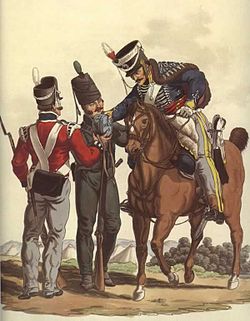
Back Кралски германски легион Bulgarian King’s German Legion German King's German Legion Spanish لژیون آلمانی پادشاه Persian King's German Legion French הלגיון הגרמני של המלך HE King's German Legion Italian King's German Legion Dutch King’s German Legion Polish King's German Legion Portuguese
| King's German Legion | |
|---|---|
 (from left to right) A 5th Line Battalion ranker, a 2nd Light Battalion sharpshooter, and a 1st KGL Hussar | |
| Active | 1803–1816 |
| Country | Electorate of Hanover; since 1814 Kingdom of Hanover |
| Branch | British Army |
| Type | Artillery Cavalry Line infantry Light infantry |
| Size | approximately 14,000 [1] |
| Garrison/HQ | Infantry at Bexhill-on-Sea Cavalry at Weymouth, Dorset |
| Battle honours |
|
| Commanders | |
| Notable commanders | |

The King's German Legion (KGL; German: Des Königs Deutsche Legion, semantically erroneous obsolete German variations are Deutsche Legion des Königs, Englisch–Deutsche Legion, Deutsche Legion) was a British Army unit of mostly expatriated German personnel during the period 1803–16. The legion achieved the distinction of being the only German force to fight without interruption against the French during the Napoleonic Wars.
The legion was formed within months of the dissolution of the Electorate of Hanover in 1803 and constituted as a mixed corps by the end of 1803. Although the legion never fought autonomously and remained a part of the British Army during the Napoleonic Wars (1804–15), it played a vital role in several campaigns, most notably the Walcheren Campaign, the Peninsular War, and the Hundred Days (1815).
The legion was disbanded in 1816. Several of the units were incorporated into the army of the Kingdom of Hanover, and became later a part of the Imperial German Army after unification in 1871.
The British German Legion, recruited for the Crimean War, is sometimes erroneously referred to as the "King's German Legion".[citation needed]
- ^ Chapell vol. 1, p. 10
© MMXXIII Rich X Search. We shall prevail. All rights reserved. Rich X Search